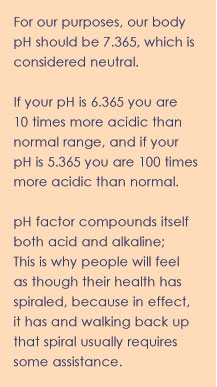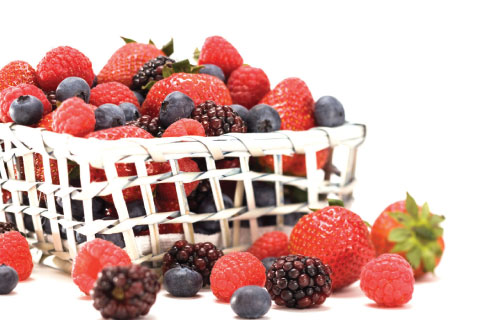pH is an acronym for the “potential of Hydrogen”, or the acid to alkaline ratio existing in all matter, and our 7.365 body pH measurement is the benchmark for measuring our health. The pH scale or chart is typically color coded and ranges from 0 to 14. Anything below 7 is acidic and it compounds itself meaning 10x, 100x, 1000x as it gradually becomes more acidic, and alkaline compounds going up the scale.
For instance, battery acid is dangerous at a 1 pH and calcium is highly alkaline at a 12 pH. Our body should be neutral at 7 pH.
While anything that tests below 7 is acidic, and above is alkaline. Testing bodily fluid, food or beverages, a swimming pool, or alkaline water, would each require different pH test kits or equipment. So, when we become too acidic, it is not falling down, it is spiraling down, and it takes focus to get back into balance. Our deep vein artery blood carries a pH measurement which can be blood tested, but suffice to say, the deep vein artery blood is not the measurement that will help us get back into balance - we want the pH of our body water.
Medical science indicates our blood should be a 7 pH. And true enough if we move that measurement 2 points either way it can be dangerous or fatal. Our body protects us, in that if we start to become too acidic it will steal high pH minerals (from our skeleton) to neutralize the acidity. Sometimes so much so that other symptoms, chronic symptoms, or disease occurs.
The pH (normal range) value of our water, tissues, muscles, ligaments, et cetera, can be likened to our body’s temperature; we each have a normal temperature range value of 98.6 degrees. When our body temperature increases or decreases we typically experience symptoms, and more importantly, we also know there is an underlying reason when our temperature is not normal. You can find thermometers in every size and fashion, and it is becoming easier to find pH test strips for body fluid and foods. Since we are not taught about our pH value range, we are uncertain about what causes us to become too acidic, and which symptoms result from being too acidic.
In today’s world of degraded food, water, and air, it is generally agreed that it is very difficult to become too alkaline. We are alkaline by design and acidic by function: Thinking, eating, digesting, feeling, physical activity, et cetera. This means when we eat, our digestive system creates acid/enzymes to digest the food (break it down), and then our intestinal tract adds more acid to break it down further to microscopic nutrition for our body. Same goes for thinking, brooding, negative thoughts, actions, et cetera, as well as working out (lactic acid builds).
pH Scale – Body
Most of us will experience the same general symptoms before ever having a diagnosis. From my experience those may include feeling sick and tired, weight gain (or loss), maybe acid reflux or bloating, tiredness around the same time each day, digestive or elimination issues, sleep issues in that it may be difficult to go to sleep, or someone else can go to sleep but cannot stay asleep, and yet other people will sleep but wake up feeling like they did not, short term memory issues regardless of age, allergies or reactions that seemed to crop up or have become much worse than they were before, and the list goes on.
After we experience some or most of the general symptoms (which most of us have considered normal and not issues for a very long time), we may go a step further into being chronic which means we are buying over the counter medication to resolve the issue on a regular basis, and after that we may even go into a diagnosis because we go to the doctor when we cannot resolve the issue ourselves.
 We have all been induced into degraded food, water, and air through our environment, and most of us have stood on the sidelines because it is happening so fast: Degraded water sources, chemicals, pesticides, growth hormones, antibiotics all lead to degraded food. Then we have additives, preservatives, enhancements, high heat processing, microwaving, and more.
We have all been induced into degraded food, water, and air through our environment, and most of us have stood on the sidelines because it is happening so fast: Degraded water sources, chemicals, pesticides, growth hormones, antibiotics all lead to degraded food. Then we have additives, preservatives, enhancements, high heat processing, microwaving, and more.
When it comes to determining our personal standards of quality regarding food, water, and air; it is only recently that we have been learning to understand our choices. So we are all still in the process of making those decisions. However, now the stakes are higher because so many of us are sick. Look left; look right, if it is not them it is you - at least for cancer, cardiovascular disease, weight issues, and now obesity... crazy stuff.
The combination is affecting our health and we know it is up to us to review our choices, our lifestyles, and assume the responsibility for improving our “at home” environment with clean food, clean air, and clean water.
pH Scale – Food
If we create acid to digest food, then there are many factors that we can consider when we talk about “how acidic” a particular food is. For example: You ingest more acid, and it creates more acid to digest red meat than chicken, chicken than turkey, turkey than fish, and fish than vegetables.
Having said that, how you chew is important, your saliva is alkalizing, therefore the more you chew the less work your stomach has to do. Chew, chew, chew, and you got it, CHEW!
Fresh food has enzymes and those enzymes will assist your body in digestion. Water will neutralize digestive acids, so heavily drinking water may affect your ability to digest at the moment and could cause additional rebound acid later on.

Your body can either work or heal, but it cannot do both, so if your body is digesting the evening meal when you go to bed you cannot heal, so the more acidic your evening meal, the less effective your healing cycle.
Produce in today’s market is coded and whenever a “9” precedes the code it is organic produce, a “4” indicates conventional. Purchasing fresh organic produce is optimal, fresh frozen is a good second choice and more practical if you do not have access to organic and natural stores within a short distance from your home.
Fruit is always a discussion because fruit has so much nutrition. However, this is about understanding the concept in practical terms, and as an example we can talk about the orange. It was not that long ago oranges were picked from the tree when theripenedand shipped to market, today they are picked green and ripened (fermented) in the trucks on the way to market. So would you consider an orange acidic?
 If you are over acidic, it is best to stay in the berry family beginning with blueberries, blackberries, raspberries, and then you make a leap to strawberries. Melons are usually lower on the acid scale; however you do make a leap to the watermelon.
If you are over acidic, it is best to stay in the berry family beginning with blueberries, blackberries, raspberries, and then you make a leap to strawberries. Melons are usually lower on the acid scale; however you do make a leap to the watermelon.
Processed foods (foods in a box) are not the best choice if you want to derive nutrition. Remember your body only recognizes grown food and just like supplements, cannot reap nutrition from something it does not recognize as natural.
Canned foods are also questionable because of the high heat and additive process that takes place (in addition to the storing), however, using canned as an occasional ingredient in an otherwise naturally grown and harvested recipe will not affect the nutrition derived from the natural source.
Red Meat was used as an example earlier as causing the most acid for digestion. It has been said that it could take days to digest today’s red meat. Think about the animal’s diet, injections, lifestyle, et cetera and you will easily see how we have taken what was an alkaline, free range grass eating (only) animal and have converted it to feed our masses. Bigger and more tender, do not equate to more healthy.
There are sources of free range grass fed beef, just as there is alkaline venison, game, et cetera, available which may be an alternative for the meat eater. Most often we find as we become more balanced, our craving for meat dissipates with our symptoms of being too acidic.
Cold water wild fish is usually the best source. While fish from very warm water or farm raised may be more trustworthy as more testing is done. Today, the source of where the fish came from and where it was packaged must be on the labels, which will help many make better choices. In addition, if you ask your wait staff at a restaurant they will be able to advise source before you order.
Shopping for all the optimal foods can be a challenge for those of us that do not live near organic or natural markets. Regardless, we all need to find shortcuts, easy ways to order and store, and keep our eye out for what is fresh and alive.
Maria J Villarreal a Certified Biofeedback Therapist holds credentials from the Institute of Quantum Biofeedback Naturopathic Medicine and is certified by the Neurotherapy and Biofeedback Certification Board. Villarreal is also a Registered Yoga Therapist and Trainer. She received her Yoga and Meditation Training and certification from the Master Yoga Academy. She has owned and operated The Purnima Wellness Center in Bonita, Calif. She has been a practitioner and educator of Plant Based Nutrition and Integrative Therapies. She provides training, consultation, educational services, and conducts classes and retreat programs in mind-body concepts.
Want to read more?
Subscribe to one of our monthly plans to continue reading this article.